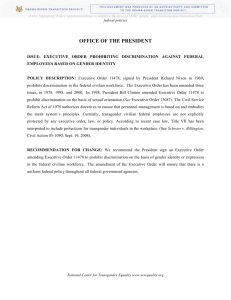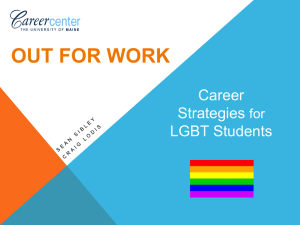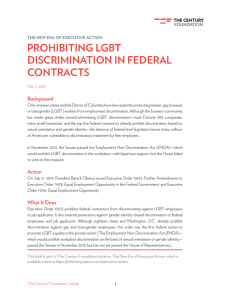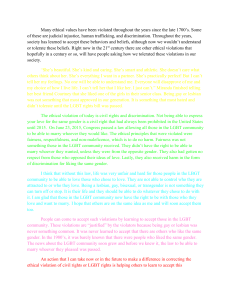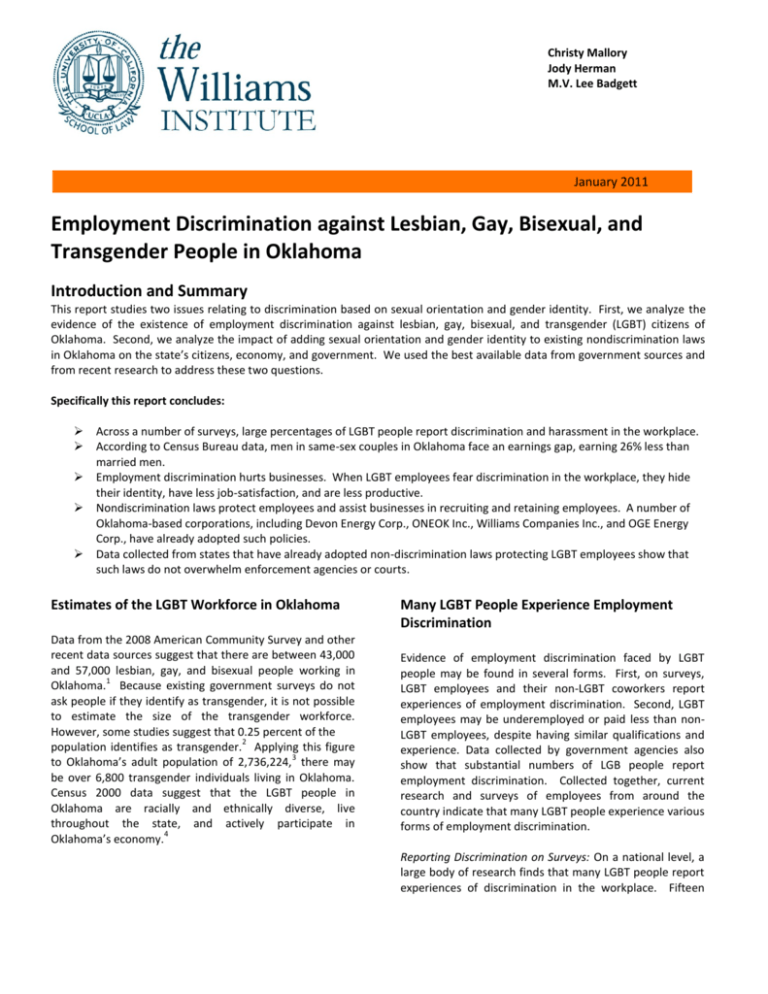
Christy Mallory
Jody Herman
M.V. Lee Badgett
January 2011
Employment Discrimination against Lesbian, Gay, Bisexual, and
Transgender People in Oklahoma
Introduction and Summary
This report studies two issues relating to discrimination based on sexual orientation and gender identity. First, we analyze the
evidence of the existence of employment discrimination against lesbian, gay, bisexual, and transgender (LGBT) citizens of
Oklahoma. Second, we analyze the impact of adding sexual orientation and gender identity to existing nondiscrimination laws
in Oklahoma on the state’s citizens, economy, and government. We used the best available data from government sources and
from recent research to address these two questions.
Specifically this report concludes:
Across a number of surveys, large percentages of LGBT people report discrimination and harassment in the workplace.
According to Census Bureau data, men in same-sex couples in Oklahoma face an earnings gap, earning 26% less than
married men.
Employment discrimination hurts businesses. When LGBT employees fear discrimination in the workplace, they hide
their identity, have less job-satisfaction, and are less productive.
Nondiscrimination laws protect employees and assist businesses in recruiting and retaining employees. A number of
Oklahoma-based corporations, including Devon Energy Corp., ONEOK Inc., Williams Companies Inc., and OGE Energy
Corp., have already adopted such policies.
Data collected from states that have already adopted non-discrimination laws protecting LGBT employees show that
such laws do not overwhelm enforcement agencies or courts.
Estimates of the LGBT Workforce in Oklahoma
Data from the 2008 American Community Survey and other
recent data sources suggest that there are between 43,000
and 57,000 lesbian, gay, and bisexual people working in
1
Oklahoma. Because existing government surveys do not
ask people if they identify as transgender, it is not possible
to estimate the size of the transgender workforce.
However, some studies suggest that 0.25 percent of the
2
population identifies as transgender. Applying this figure
3
to Oklahoma’s adult population of 2,736,224, there may
be over 6,800 transgender individuals living in Oklahoma.
Census 2000 data suggest that the LGBT people in
Oklahoma are racially and ethnically diverse, live
throughout the state, and actively participate in
4
Oklahoma’s economy.
Many LGBT People Experience Employment
Discrimination
Evidence of employment discrimination faced by LGBT
people may be found in several forms. First, on surveys,
LGBT employees and their non-LGBT coworkers report
experiences of employment discrimination. Second, LGBT
employees may be underemployed or paid less than nonLGBT employees, despite having similar qualifications and
experience. Data collected by government agencies also
show that substantial numbers of LGB people report
employment discrimination. Collected together, current
research and surveys of employees from around the
country indicate that many LGBT people experience various
forms of employment discrimination.
Reporting Discrimination on Surveys: On a national level, a
large body of research finds that many LGBT people report
experiences of discrimination in the workplace. Fifteen
studies conducted since the mid-1990s have found that 1543 percent of LGBT respondents experienced
5
discrimination in the workplace. For example, a 2007
survey found that 16 percent of lesbians and gay men and
5 percent of bisexual people reported being fired or denied
6
a job because of their sexual orientation. Numerous local
community surveys of LGBT people find that sexual
orientation discrimination is also commonly reported in
7
those areas.
The 2008 General Social Survey, which is a recent national
survey, included questions about discrimination on the
basis of sexual orientation. This survey found that 37
percent of gay and lesbian people reported workplace
harassment in the last five years, and 12 percent reported
8
losing a job because of their sexual orientation.
When transgender people are surveyed separately, they
report similar or higher levels of employment
discrimination. In 2009, the largest national survey of
transgender people to date included people from every
state in the U.S. The survey revealed that 97% of the 6,450
people surveyed had experienced harassment or
mistreatment at work, and 47% had been discriminated
against in hiring, promotion, or job retention because of
9
their gender identity. Eleven local surveys of transgender
people conducted between 1996 and 2006 found that at
least 20% and as many as 57% reported having experienced
10
some form of employment discrimination. A 2009 survey
of transgender people living in California found that 67%
reported experiences with workplace harassment or
11
discrimination directly related to their gender identity.
Because every survey of LGBT employees finds evidence of
discrimination, regardless of the specific place studied, we
believe that discrimination against LGBT people also occurs
in Oklahoma. In fact, a 2004 survey of 585 LGBT residents
of Tulsa, Oklahoma found that almost 22% of respondents
had experienced sexual orientation or gender identity
12
discrimination at work in the last five years.
Figure 1. Employment Experiences of LGBT People in Tulsa
45%
22%
Experienced
Employment
Discrimination
22%
26%
Conceal LGBT Status Employer Has Sexual Employer Has
at Work
Orientation NonGender Identity
Discrimination
Non-Discrimination
Policy
Policy
Source: Tulsa Community Foundation, Tulsa Reaches Out (TRO)
Project, Community Service Council of Greater Tulsa, 2005
LGBT People Have Lower Earnings: Data from the US
Census allows us to examine the employment and earnings
for individuals in same-sex couples who live in Oklahoma.
While it isn’t possible to identify single LGBT people on the
Census, a large body of research has relied upon Census
data to provide a demographic picture of individuals living
in same-sex couples.
Census data show that men in same-sex couples in
Oklahoma earn less than married men. On average, men in
same-sex couples in Oklahoma earn $29,232 each year,
13
significantly less than $39,462 for married men.
The
median income of men in same-sex couples in Oklahoma is
14
$24,000, or 23% less than that of married men ($31,000).
Men with same-sex partners earn lower wages despite the
fact that they are more likely to have a college degree than
15
are married individuals, a comparison that supports the
possibility of unequal treatment of people in same-sex
couples by employers. Women in same-sex couples in
Oklahoma earn slightly more than married women, with
earnings averaging $21,348 and $20,913 per year,
respectively (with a median yearly income of $18,000 for
both). Women in same-sex couples earn less than married
men as well as men in same-sex couples.
Figure 2. Men’s Individual Earnings in Oklahoma
$39,462
$31,000
$29,232
$24,000
Mean
Men in Same-Sex Couples
Median
Married Men
Source: American Community Survey, 2008
These findings are not unique to Oklahoma. Analyses of
national data consistently find that men in same-sex
couples and gay men earn 10-32% less than similarly
16
qualified heterosexual men.
Surveys of transgender
people find that they have high rates of unemployment
17
and very low earnings. A recent study suggests that the
wage gap for gay men is smaller in states that implement
nondiscrimination laws, suggesting that such laws curb
18
discrimination against LGBT people.
Filing Complaints of Discrimination with State Agencies:
Evidence of employment discrimination against LGBT
employees is also observed through data on the filing of
discrimination complaints with state agencies. Currently,
21 states and the District of Columbia prohibit employment
2
discrimination on the basis of sexual orientation, and 12
states and the District of Columbia also prohibit
employment discrimination based on gender identity. A
2008 study examined complaints filed by employees in
these states and found that LGB workers filed complaints
of employment discrimination at similar rates as women
19
filing sex discrimination complaints. Both LGB employees
and women filed complaints at a rate of approximately 5
complaints per 10,000 workers in those groups. Race
complaints were filed at a slightly higher rate of 7
complaints per 10,000 workers who are people of color.
Figure 3. National Per Capita Discrimination Complaint Rates to
State Administrative Agencies (Per 10,000)
6.5
4.7
Sexual
Orientation
5.4
Sex
Race
Source: Williams Institute Analysis, 2008
Case Law and Other Documented Examples of Employment
Discrimination: Since 1994, there have been several cases
of employment discrimination related to sexual orientation
or gender identity brought in Oklahoma against both public
and private employers.
In 2004, Oklahoma City reached a settlement with a
transgender police officer who was harassed and fired
because of her gender identity. The officer, a decorated
army veteran, was fired even though she had received an
award from the Department of Justice for her service as a
police officer. In Schonauer v. City of Oklahoma, ex. rel.
20
Oklahoma City Police Department, the plaintiff sued the
Oklahoma Police Department and the City of Oklahoma,
her employer of more than ten years, for gender
discrimination, hostile work environment and disparate
21
treatment, based on gender. When Ms. Schonauer was
first hired by the police department in 1992, she was male;
22
in 2001, she underwent gender reassignment surgery.
After the surgery, she faced constant harassment from her
co-workers, which she alleges interfered with her ability to
23
do her job. However, she continued performing her job
and even improved relations between the police
department and the Asian, Hispanic, and gay and lesbian
24
communities.
Despite this achievement, and her
25
exceptional performance prior to 2001, the police
department removed her from patrol duties, gave her an
interim clerical position, and then placed her on paid
26
administrative leave.
In Saladin v. Turner, a waiter at a high-end Oklahoma
restaurant sued his employer, the restaurant owner, for
27
discrimination under the Americans with Disabilities Act.
The plaintiff was one of the restaurant’s most wellrespected waiters and was liked by both patrons and co28
workers. He was openly gay and involved with a long
29
term partner who was infected with HIV. Many regular
patrons would inquire about plaintiff’s partner and
30
plaintiff’s charitable activities in the HIV/AIDS community.
When the restaurant manager learned of this, she
requested that plaintiff refrain from these conversations
31
because other customers had allegedly complained. The
restaurant owner did not think this solution was sufficient
and decided to suspend the waiter for one month without
pay, the longest suspension ever imposed in the
32
restaurant’s history.
During the suspension, the
defendant terminated the plaintiff’s employment, alleging
that another employee had told the manager that plaintiff
33
had quit.
The plaintiff subsequently applied for
unemployment benefits, but was initially denied because
34
the defendant claimed he had been insubordinate. The
plaintiff then filed a discrimination complaint with the
35
EEOC. The district court held in favor of the waiter,
finding that the restaurant owner had suspended and
subsequently terminated the plaintiff solely because of his
36
association with his partner, who had AIDS.
In Joffe v. Vaughn, the plaintiff sued his former employer
for wrongful termination, slander and intentional infliction
37
of emotional distress. The plaintiff was a news anchor at a
38
local television station. His co-anchor told the station’s
news director that the plaintiff had engaged in a
homosexual liaison with his hair dresser, specifically
claiming that the plaintiff had frequented a well-known
“gay bar,” picked up a stranger, and took him back to his
39
apartment for sex. Within a month of the allegation and
without any investigation or substantiated evidence, the
defendant told the plaintiff that he must either resign or
40
suffer termination. The news anchor refused to resign
and was fired without cause under the termination
41
provision of his employment contract. He quickly became
the subject of negative rumors and speculation throughout
Tulsa, despite his recent marriage to his long-time
42
fiancée. After his own investigation into the allegations,
the plaintiff discovered the name of his accuser and filed
suit against both his co-anchor and the station. The
emotional strain of the incident, however, proved to be too
much, and the plaintiff took his own life before completion
43
of the case. At trial, the jury found in favor of the plaintiff
on the theory of intentional infliction of emotional distress
44
and awarded $2 million. The appellate court upheld the
3
award, in part, because it did not find the unsubstantiated
45
allegations about plaintiff to be credible.
In 2004, a librarian employed at the Oklahoma City Branch
of Langston University (Oklahoma’s only historically black
college and university) for approximately three years,
began the process of transitioning from male to female.
After she returned from a professional conference, she
discovered that a student had circulated over 100 copies of
a hate-filled petition calling for her removal from campus
and had posted flyers to the same effect around the
campus. Every reason cited in support of the librarian’s
removal was related to her gender identity. When the
librarian confronted the library director about the
situation, he told the librarian that the student had a right
to freedom of speech and that he would not do anything.
When other students complained to the library director
about the flyers, he supported the student who had passed
them out. The student then printed a second flyer stating
that “God wished [her] dead” and that he hoped she would
die. When she confronted administrators about the second
flyer, the librarian was told her concerns were unwarranted
and she was the one creating problems. The following
semester her schedule was changed so that she would
have to leave the building at 10:00PM—long after other
staff and faculty had gone home. Fearing that she would be
unsafe on campus at that hour, she had no choice but to
46
resign.
In 2007, a gay electronics technician who worked out of a
city firehouse reported, after another employee learned
that he was gay, that he began to experience harassment
from co-workers. When a new employee complained about
having to clean the showers at the firehouse, the
technician commented that they were so filthy that he
wouldn’t take a shower there. The new employee replied
that, according to what he had heard from others, he had
thought that “you'd like that [implying a shower with other
men].” One coworker repeatedly screamed at the
technician, physically intimidated him, and twice
threatened to kill him. When the individual complained, his
shift was changed against his wishes so that he would not
work the same time as that co-worker. The department
administrator refused to give him a copy of the employer’s
47
policy vis-à-vis sexual harassment and nondiscrimination.
In 2008, a municipal police officer transitioned from male
to female while on the job. Thereafter, she experienced
severe harassment based on her gender identity. After her
transition, the police department also insisted that she
undergo psychological evaluations. They transferred her to
48
an unfavorable position.
Effects of Nondiscrimination Laws on Businesses
and Other Employers
Currently, Oklahoma County and the cities of Tulsa, Del
City, Altus, McAlester, Vinita, and Miami prohibit
employment discrimination on the basis of sexual
orientation for public employees by local government
49
policy or ordinance. Oklahoma’s two largest universities,
The University of Oklahoma and Oklahoma State
University, and at least one Oklahoma school district, Tulsa
Public Schools, have policies against employment
50
discrimination based on sexual orientation. Additionally,
several Oklahoma-based private corporate employers have
adopted policies prohibiting discrimination based on sexual
orientation and/or gender identity; among them are Devon
Energy Corp., OGE Energy Corp., ONEOK Inc., and Williams
51
Companies Inc.
These
Oklahoma
employers
are
adopting
nondiscrimination policies that place them in the
mainstream of corporate practice in the United States.
More than two-thirds of Fortune 1000 companies prohibit
discrimination on the basis of sexual orientation, and onequarter prohibit discrimination on the basis of gender
52
identity.
The widespread adoption of these policies suggests that
nondiscrimination policies make good business sense.
Nondiscrimination policies increase the ability to recruit
and retain qualified employees and can improve the
productivity and satisfaction of employees. Businesses are
most successful when they can recruit, hire, and retain
employees on the basis of talent, not personal
characteristics that have no impact on an employee’s
ability to perform a job well.
Numerous studies from various academic disciplines
suggest that LGBT workers will have greater job satisfaction
and be more productive workers if they have legal
protection from discrimination.
The key link here is
between discrimination and disclosure of one’s sexual
orientation or gender identity. Studies have demonstrated
that discrimination keeps LGBT workers from revealing
their sexual orientation in the workplace. Although having
experienced discrimination directly is a powerful reason for
some to “stay in the closet,” studies show that LGBT people
who fear discrimination are also less likely to reveal their
sexual orientation or gender identity to co-workers and
53
supervisors.
Employers have a stake in these individual decisions, since
disclosure has potentially positive benefits to workers’
well-being and job performance. Studies find that lesbians
and gay men who have come out report lower levels of
anxiety, less conflict between work and personal life,
4
greater job satisfaction, more sharing of employers’ goals,
higher levels of satisfaction with their co-workers, more
54
self-esteem, and better physical health.
Nondiscrimination Laws Do Not Overwhelm
Enforcement Agencies
On the other hand, when fear of discrimination causes
LGBT employees to conceal their sexual orientation or
gender identity, employers experience negative costs along
with LGBT people themselves. The time as well as social
and psychological energy that are required to maintain a
hidden identity would be, from an employer’s perspective,
55
better used on the job. The fact that nearly 22 percent of
respondents to an LGBT needs assessment survey in Tulsa
reported they were not open about their LGBT status at
work suggests that nondiscrimination laws and policies
could improve the work lives and productivity of LGBT
56
workers in Oklahoma.
Some question whether a sexual orientation and gender
identity anti-discrimination law may create an increased
burden on government agencies. However, even if LGBT
people filed complaints at the same rates that women file
sex discrimination complaints or minorities file
racial/ethnic discrimination complaints, government
agencies would not be overwhelmed. A 2008 national
study of data from 1999-2007 identified the average
annual number of sexual orientation complaints for all
states with protection for sexual orientation in the
workplace at just over 1,200, versus race and sex
59
complaints at 11,500 and 13,800, respectively. That study
estimated that for every 10,000 LGB workers, there are
approximately 5 complaints filed on the basis of sexual
orientation per year.
A 2009 Human Rights Campaign survey provides recent
evidence of the harmful impact of an unsupportive work
environment on LGBT employees. The study finds that
employees who are not out to anyone in the workplace
were less productive, more distracted, and less likely to
stay in their current positions. Specifically, when compared
to more open employees, closeted employees were:
More likely to report feeling depressed (44%)
than were those employees who were out (26%);
More likely to avoid a social work event (29%)
than out employees (18%);
More likely to report feeling distracted at work
(31% versus 25%);
More likely to feel exhausted (30% versus 12%);
and
More likely to have searched for another job (24%
57
versus 16%).
Nondiscrimination policies can improve the workplace
climate and influence choices about disclosure and
concealment. Several studies have found higher levels of
disclosure in workplaces when employers have their own
non-discrimination policies that include sexual orientation
58
or gender identity.
Using the earlier estimates of the number of LGB people
working in Oklahoma (43,000-57,000) and the complaint
rate, we predict that in a given year, approximately 21-29
LGB workers would file a complaint alleging sexual
orientation discrimination. Given these estimates, there is
no evidence that expanding employment protections to
LGB people would encumber the services of existing
agencies.
Currently, there are not enough data to do a similar
analysis of gender identity discrimination complaints.
However, complaints of discrimination based on gender
identity were collected from two states and the District of
Columbia. The data obtained support the position that
passing protections for gender identity in employment will
not result in a flood of complaints to enforcement
agencies—6 complaints were filed with the District of
Columbia in 2006, 4 complaints were filed with Oregon
from 2003 through 2006, and 2 complaints were filed with
60
Rhode Island from 2006 through 2007.
5
Endnotes
1
We computed this range by first estimating the number of LGB people in the U.S. workforce (4,720,323-6,293,831, which is 3%-4% of the U.S.
workforce). Next we assume that the same percentage of LGB workers live in Oklahoma as the percentage of same-sex couples living in
Oklahoma (0.91%). In other words, we multiply the U.S. workforce by 3% and 4% and then multiply that figure by 0.0091. Multiplying the
percentage of the country’s same-sex couples that live in Oklahoma (.91%) by the estimated number of LGB people in the U.S. workforce. The
workforce total for 2008 is 157,345,776 (2008 ACS Table S2301: Employment Status). Percentage of same sex couples calculated from U.S.
Census Bureau, 2008 American Community Survey, Unmarried Partner Households by Sex of Partners, B11009. The 3%-4% range is based on
findings from the 2002 National Survey of Family Growth and the 2008 General Social Survey (See Gary J. Gates, the Williams Institute, Samesex Couples and the Gay, Lesbian, Bisexual Population: New Estimates from the American Community Survey, p. 11, apx. 1 (Oct. 2006), available
at http://www.law.ucla.edu/williamsinstitute/publications/SameSexCouplesandGLBpopACS.pdf; Gary J. Gates, the Williams Institute, Sexual
Minorities in the 2008 General Social Survey: Coming Out and Demographic Characteristics, p. i (Sept. 2010).)
2
The Human Rights Campaign, Transgender Population and the Number of Transgender Employees, available at
http://www.hrc.org/issues/9598.htm.
3
U.S. Census Bureau, 2008 American Community Survey, Universe: Population 18 Years and Over: Total, Oklahoma, B15001.
4
Adam P. Romero, Clifford J. Rosky, M.V. Lee Badgett & Gary J. Gates, the Williams Institute, Census Snapshot: Oklahoma (1 June 2008),
available at http://www.law.ucla.edu/williamsinstitute/publications/OklahomaCensusSnapshot.pdf.
5
M.V. Lee Badgett, Holning Lau, Brad Sears & Deborah Ho, the Williams Institute, Bias in the Workplace: Consistent Evidence of Sexual
Orientation and Gender Identity Discrimination Executive Summary, 84 CHICAGO-KENT L. REV. 559 (2002).
6
Gregory M. Herek, Hate Crimes and Stigma-Related Experiences Among Sexual Minority Adults in the United States: Prevalence Estimates from
a National Probability Sample, 24 J. INTERPERSONAL VIOLENCE 54, 54-74 (2009).
7
See Badgett et al., supra note 5.
8
Analysis conducted by The Williams Institute, unpublished (2009).
9
National Center for Transgender Equality & the National Gay and Lesbian Task Force, National Transgender Discrimination Survey: Preliminary
Findings 1 (Nov. 2009), available at http://transequality.org/Resources/NCTE_prelim_survey_econ.pdf.
10
Badgett et al., supra note 5.
11
Transgender Law Center, The State of Transgender California (Mar. 2009), available at
http://www.transgenderlawcenter.org/pdf/StateofTransCAFINAL.pdf.
12
Tulsa Community Foundation, Tulsa Reaches Out (TRO) Project, and the Community Service Council of Greater Tulsa, Tulsa’s Gay Community:
A Needs Assessment Report (Sept. 2005), available at www.csctulsa.org/current%20studies.htm.
13
Adam P. Romero, Clifford J. Rosky, M.V. Lee Badgett & Gary J. Gates, the Williams Institute, Census Snapshot: Oklahoma (January 2008).
14
Id.
15
Id.
16
Badgett et al., supra note 5.
17
Id.; The State of Transgender California, supra note 11.
18
Gary J. Gates, The Impact of Sexual Orientation Anti-discrimination Policies on the Wages of Lesbians and Gay Men (April 2009), available at
http://papers.ccpr.ucla.edu/papers/PWP-CCPR-2009-010/PWP-CCPR-2009-010.pdf.
19
Christopher Ramos, M.V. Lee Badgett & Brad Sears, Evidence of Employment Discrimination on the Basis of Sexual Orientation and Gender
Identity: Complaints Filed with State Enforcement Agencies, 1999-2007 (Nov. 2008), available at
http://www.law.ucla.edu/williamsinstitute/pdf/PACR.pdf
20
Case No. CIV-05-104-W (W.D. Okla. 2005).
21
Memorandum from the City of Oklahoma City Office of the Municipal Counselor to Mayor and Council (Sept. 27, 2005), http://bit.ly/3IVVNk
(last visited Sept. 6, 2009).
22
Richard Green, Transgender Officer Sues Police in OKC, TULSA WORLD, Dec. 29, 2004, at A15.
23
Reuters, Sex-Change Oklahoma Officer Files Harassment Suit, EXP. INDIA, Dec. 29, 2004, http://bit.ly/aW3mM (last visited Sept. 6, 2009).
24
Oklahoma Office of Personnel Management Affirmative Action Plan, http://bit.ly/sKEIp (last visited Sept. 6, 2009).
25
See Chad Graham, Gays in the Red States, ADVOCATE, Feb. 15, 2005, available at http://bit.ly/NFRP1 (stating that Ms. Schonauer received an
award from the Department of Justice for her performance as an Oklahoma police officer).
26
Oklahoma Office of Personnel Management Affirmative Action, supra note 6.
27
936 F. Supp. 1571 (N.D. Okla. 1996).
28
Id. at 1575.
29
Id.
30
Id.
31
Id.
32
Id.
33
Id. at 1578
34
Id. at 1576.
35
Id.
36
Id. at 1581.
37
873 P.2d 299 (Okla. Civ. App. 1993).
38
Id. at 301.
39
Id. at 302, 306.
40
Id. at 302.
6
41
Id.
Id.
43
Id.
44
All other claims were dismissed by the trial court. Id.
45
Id. at 304, 306.
46
Email from Ken Choe, Senior Staff Attorney, American Civil Liberties Union, to Brad Sears, Executive Director, the Williams Institute (Sept. 11,
2009, 14:10:00 PST) (on file with the Williams Institute).
47
E-mail from Jon Davidson, Legal Director, Lambda Legal, to Nan D. Hunter, Legal Scholarship Director, the Williams Institute (Feb. 11, 2009,
12:18:00 EST) (on file with the Williams Institute).
48
Id.
49
TEN Institute, Municipal Equality Database, August 15, 2010, available at http://www.scribd.com/doc/33127989/Municipalities-Database;
The Equality Network, New Report Shows Surprising Gains for Gay Oklahomans, June 16, 2010, available at
http://www.scribd.com/doc/33137283/New-Report-Shows-Surprising-Gains-for-Gay-Oklahomans; Oklahoma County Employee Handbook, May
5, 2008, pg. 39; P.J. Lassek, Council adds sexual orientation to city’s nondiscrimination policy, Tulsa World, June 17, 2010; Code of Ordinances,
City of McAlester, Oklahoma Part 1 Charter Art. 7.02 (prohibiting discrimination in city government employment).
50
University of Oklahoma Staff Handbook, Chapter 3.0, Sec. 3.3, available at: http://hr.ou.edu//handbook/chapterThree.asp; Oklahoma State
University Policy and Procedures, 1-0101 Equal Opportunity/Affirmative Action, May 2004, available at:
https://stillwater.sharepoint.okstate.edu/Policies/Shared%20Documents/Forms/AllItems.aspx; Tulsa Public Schools’ Non-Discrimination
Statement, available at: http://www.tulsaschools.org/district/NDS.shtm.
51
Human Rights Campaign, supra note 29. Human Rights Campaign, Employer Database,
http://www.hrc.org/issues/workplace/search.asp?form=private_quick_search.aspx (last visited Mar. 9 2010).
52
Samir Luther, Human Rights Campaign, How Fortune-Ranked Companies Stack Up On LGBT Workplace Policies, September 21st, 2009,
available at http://www.hrcbackstory.org/2009/09/how-fortune-ranked-companies-stack-up-on-lgbt-workplace-policies/.
53
See e.g., Lambda Legal & Deloitte Financial Advisory Services, 2005 Workplace Fairness Survey (2006), available at
http://data.lambdalegal.org/pdf/641.pdf; Task Force on Diversity in the Profession, Minnesota State Bar Association, 2005 Self-Audit for Gender
& Minority Equity: A Research Study of Minnesota Law Firms, Non-Firm Employers and Individual Lawyers (2006), available at
http://www.mnbar.org/committees/DiversityTaskForce/Diversity%20Report%20Final.pdf; James M. Croteau & Julianne S. Lark, On Being
Lesbian, Gay or Bisexual in Student Affairs: A National Survey of Experiences on the Job, 32 NASPA JOURNAL 189 (1995); Martin P. Levine & Robin
Leonard, Discrimination against Lesbians in the Work Force, 9 JOURNAL OF WOMEN AND CULTURE 700 (1984).
54
Karen M. Jordan & Robert H. Deluty, Coming Out for Lesbian Women: Its Relation to Anxiety, Positive Affectivity, Self-Esteem, and Social
Support, 35 J. OF HOMOSEXUALITY 41 (1998); Nancy E. Day & Patricia Schoenrade, Staying in the Closet Versus Coming Out: Relationships Between
Communication about Sexual Orientation and Workplace Attitudes, 50 PERSONNEL PSYCHOL. 147 (1997); Jeanine M. Driscoll et al., Lesbian Identity
and Disclosure in the Workplace: Relation to Occupational Stress and Satisfaction, 48 J. OF VOCATIONAL BEHAVIOR 229 (1996); Kristin H. Griffith &
Melanie R. Hebl, The Disclosure of Gay Men and Lesbians: “Coming Out” at Work, 87 J. OF APPLIED PSYCHOL. 1191 (2002).
55
See generally, M.V. Lee Badgett, Money, Myths, and Change: The Economic Lives of Lesbians and Gay Men (Chicago: University of Chicago
Press, 2001); James D. Woods, The Corporate Closet: The Professional Lives of Lesbians and Gay Men in America (New York: Free Press, 2004);
Human Rights Campaign, Degrees of Equality: A National Study Examining Workplace Climate for LGBT Employees (2009), available at
http://www.hrc.org/documents/HRC_Degrees_of_Equality_2009.pdf.
56
Tulsa Community Foundation, et al, supra note 12.
57
Human Rights Campaign, Degrees of Equality: A National Study Examining Workplace Climate for LGBT Employees, supra note 58.
58
S.B. Button, Organizational Efforts to Affirm Sexual Diversity: A Cross-Level Examination, 86 J. APPLIED PSYCH. 17 (2001); Badgett, supra note 58;
Lambda Legal & Deloitte Financial Advisory Services, 2005 Workplace Fairness Survey (2006), available at
http://data.lambdalegal.org/pdf/641.pdf.
59
Ramos et al., supra note 18.
60
Ramos et al., supra note 18.
42
7
ACKNOWLEDGEMENTS
The authors would like to thank Brad Sears and Gary Gates for their feedback and Taya Ball for her editorial and
formatting assistance.
ABOUT THE AUTHORS
Christy Mallory, JD, is a legal research fellow the Williams Institute, UCLA School of Law.
Jody Herman, PhD, is the Peter J. Cooper Public Policy fellow at the Williams Institute, UCLA School of Law.
M.V. Lee Badgett, PhD, is the Research Director at the Williams Institute, and Director of the Center for Public
Policy and Administration at the University of Massachusetts Amherst, where she is also a Professor of Economics.
She studies family policy and employment discrimination related to sexual orientation.
ABOUT THE WILLIAMS INSTITUTE
The Williams Institute on Sexual Orientation and Gender Identity Law and Public Policy at UCLA School of Law
advances law and public policy through rigorous, independent research and scholarship, and disseminates its work
through a variety of education programs and media to judges, legislators, lawyers, and other policymakers and the
public. These studies can be accessed at the Williams Institute website
For more information, contact:
The Williams Institute
UCLA School of Law
Box 951476
Los Angeles, CA 90095-1476
williamsinstitute@law.ucla.edu
www.law.ucla.edu/williamsinstitute
8

